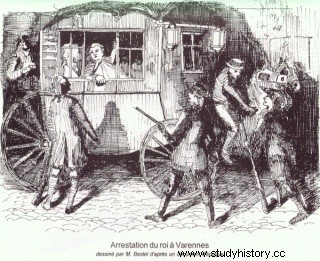
Inconceivable for a clergy who saw themselves alienated from a political process which they largely disapproved of, condemned by the pope and unacceptable for a king firmly attached to the dogmas of the monarchy by divine right, the Civil Constitution of the Clergy revealed the misunderstanding established between the king and the Assembly at the start of the Revolution.
Weak and weak-willed, Louis XVI sanctioned the Civil Constitution of the Clergy on December 26, 1790. However, won over to the ideas of the refractory*, he began to play, with the active help of Marie-Antoinette, a double game. Seeming to submit to the Constituent Assembly, he secretly hatched the ruin of the Revolution. Thus, having been refused access to the Château de Saint-Cloud during the 1791 Easter celebrations, Louis XVI decided to go to the eastern borders to try to restore the internal situation. Leaving with his family on the night of June 20, he was arrested the same evening in Varennesan-Argonne*, after having been reluctant to use force to continue his journey. On June 25, the hearse of the monarchy returned to Paris in the midst of a threatening and furious crowd at having been betrayed by its king. Despite the approximate and reassuring explanations of the monarchist deputies, the people of Paris are aware of having been deceived. The break was decisive between France, favorable to the ideas of 1789, but attached to its king, and this monarch who was preparing to make a pact with the enemy powers.
In Paris, in full effervescence, the a number of clubs where the deputies of the Constituent Assembly met. Soon, the politics of France were made more in the hall of the Cordeliers or the Jacobins than in an assembly that hesitated to condemn Louis XVI for his attempt to flee. Faced with this leniency, the municipality of Paris organized a large demonstration on the Champ-de-Mars on July 17, during which the people of the capital were invited to come and sign a petition demanding the forfeiture of the king. Very quickly, major clashes took place at the very place where, a year earlier, the royal family had been acclaimed; then suddenly the irreparable happens. The National Guard fires on the crowd:Bailly and La Fayette, symbols of the victorious Revolution, have just covered their hands with the blood of the people. A further step in the revolutionary escalation has just been climbed.
A few weeks later, the Constituent Assembly broke up; it has completed its work with a view to drafting a new Constitution. On September 14, Louis XVI took an oath of fidelity to the constitutional laws adopted, after it had been decided that the members of the new assembly could not be taken from among those of the Constituent Assembly.
